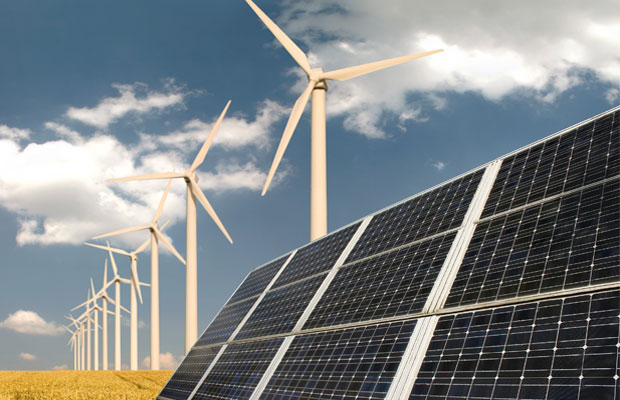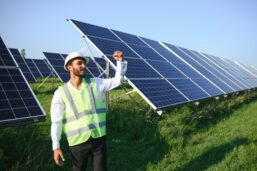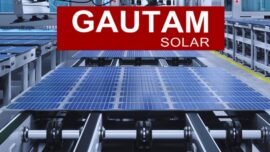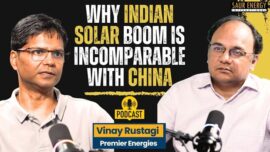
The New & Renewable Energy sector has witnessed the highest ever-solar power and wind power capacity addition over the last two years since April 2014.
The Government has set a target of 175 GW of renewable energy capacity by end of 2022, making it the largest expansion in the world and providing plenty of opportunities for investors. The Government is also committed to Clean Energy and is driving efforts to achieve 40% power installed capacity from non-fossil-fuel-based energy resources and reducing emissions by 33- 35% of its GDP by 2030.
The New & Renewable Energy sector has witnessed the highest ever-solar power and wind power capacity addition over the last two years since April 2014.
Here are the key achievements in the sector during the last 2 years released by Ministry of Commerce and Industry.
- The world’s largest 648-MW solar power plant was commissioned in Tamil Nadu on September 21, 2016.
- A 157% increase in solar power capacity addition (4132 MW) during the last two years (FY2014-15 & FY 2015-16).
- Highest ever wind power capacity addition of 3300 MW in 2015-16.
- 34 solar parks of aggregate capacity of 20,000 MW have been sanctioned for 21 states. INR 356.63 crores has been released to Solar Energy Corporation of India for the projects.
- 31,472 solar water pumps were installed in 2015-16; this is higher than total number of pumps installed during the last 24 years since 1991.
- 501 MW grid connected solar rooftop projects have been installed in the country.
Capacity Addition
As on October 31, 2016, cumulative capacity of 46.33 GW grid interactive renewable energy capacity has been installed in the country, which constitutes 15% of the total installed power generation capacity of 307.69 GW.

3575 MW capacity has been added from various renewable energy sources as on October 31, 2016 for FY2016-17.
Policy Initiatives & Investments
FDI Policy
100% FDI is allowed under automatic route for projects of renewable power generation and distribution subject to provisions of The Electricity Act, 2003.
FDI Equity Inflow
Total FDI equity inflow in the non-conventional energy sector during April 2014 to September 2016 was
USD 1.77 billion. The major FDI equity inflow in the sector are provided in the below table.
|
Foreign Collaborator |
Country |
Indian Company |
FDI Equity Inflow (USD Million) |
| MUDAJAYA Corporation Berhad | Malaysia | RKM Powergen Pvt Ltd | 77.18 |
| GAMESA EOLICA S L |
Spain |
GAMESA Wind Turbines Pvt Ltd |
66.76 |
| AIRRO (Mauritius) Holdings | Mauritius | DILIGENT Power Pvt Ltd | 62.44 |
|
Greenko Mauritius |
Mauritius |
M/S GREENKO Energies Pvt Ltd |
59.52 |
| Azure Power Global Ltd | Mauritius | AZURE Power India Pvt Ltd | 54.11 |
|
ORIX Corporation |
Japan |
TADAS Wind Energy Private Limited |
53.23 |
| OSTRO Renewal Power Ltd | Mauritius | OSTRO Energy Pvt Ltd | 45.81 |
|
Asian Development Bank |
Philippines |
Renew Power Ventures Private Limited |
44.69 |
| AIRRO Singapore Pte Ltd | Singapore | DILIGENT Power Pvt Ltd | 41.07 |
|
ORIX Corporation |
Japan |
LALPUR Wind Energy Private Limited |
37.75 |
| ENEL Green Power
Development B.V. |
Netherlands |
BLP Energy Private Limited |
32.61 |
| DEG-DEUTSCHE-Investitions- Und-Entwicklun |
Germany |
WELSPUN Renewables
Energy Pvt Ltd |
32.50 |
| ENERK International Holdings
Ltd |
Seychelles |
RKM POWERGEN Pvt Ltd |
32.50 |
| OSTRO Renewal Power Limited | Mauritius | OSTRO Energy Pvt Ltd | 32.21 |
| AREVA Solar Inc | U.S.A | AREVA Solar India Pvt Ltd | 31.53 |
Fiscal Incentives
The government has provided a whole host of financial and fiscal incentives for promoting renewable energy projects.
Fiscal incentives such as accelerated depreciation, concessional custom duty, excise duty exemption, income tax holidays for 10 years to promote renewable energy.
To promote solar rooftops, INR 5,000 crore has been approved for implementation of Grid Connected Rooftops systems over a period of five years upto 2019-20 under National Solar Mission (NSM).This will support installation of 4,200MW Solar Rooftop systems in the country in the next five years (December 2015).
- Acapital subsidy of 30 percent of the project cost for general States/UTs and 70 percent for Special category States (North East including Sikkim, Uttarakhand, HP, J&K, Lakshadweep, Andaman & Nicobar) excluding industrial and commercial establishments.
- Inclusion of rooftop solar as part of housing loan by banks /NHB
- Clean Energy Fund – Clean environment cess on coal, lignite and peat has been doubled from Rs.200 per tonne to Rs.400 per tonne, to promote use of renewable energy sources (Budget 2016-17).
- Renewable energy projects included in priority sector lending norms of commercial banks (RBI, April 2015).
- Renewable Generation Obligation (RGO) – New coal/lignite based thermal plants after specified date to also establish/procure/purchase renewable capacity (January2016).
- Inter-sate transmission charges and losses for Wind and Solar projects have been waived off (January 2016).
- Provision of rooftop solar and 10% renewable energy is now mandatory under Mission Statement and Guidelines for development of smart cities (October 31, 2016).
Scheme for Development of Solar Parks and Ultra Mega Solar Power Projects
MNRE launched the scheme for development of Solar Parks and Ultra Mega Solar Power Projects on December 12, 2014. 25 Solar Parks with capacity of 500 MW and above (smaller parks of lesser capacity for Himalayan and hilly regions) and Ultra Mega Solar Power Projects targeting over 20,000 MW of solar power installed capacity will be set up within a span of 5 years starting from 2014-15.
Scheme for Development of Solar PV Power Plants on Canal Banks/ Canal Tops
“Pilot-cum-Demonstration Project for Development of Grid Connected Solar PV Power Plants on Canal Banks and Canal Tops” was approved on December 5, 2014. A target of 100 MW Grid Connected Solar PV Power Plants on Canal Banks and Canal Tops (50 MW on Canal Tops and 50 MW on Canal Banks) has been set. Some of the incentives under the scheme are:
- INR 3 crore/MW or 30% of the project cost, whichever is lower, for Canal Top SPV projects and Rs. 1.5 crore/MW or 30% of the project cost, whichever is lower, for Canal Bank SPV projects
- Assistance of INR 225 crore for 100 MW (50 MW on Canal Tops and 50 MW on Canal Banks) to be disbursed over a period of maximum 2 years post sanctioning of the plants. 16 MW of canal top/ canal bank solar projects have been commissioned as on December 16, 2016 under the scheme.
Other Incentives to promote renewable energy projects
- Various projects of total 356MW capacity have been sanctioned and projects of 84 MW capacity have been tendered for Indian defense and paramilitary forces using solar cells and modules manufactured in India.
- A Joint Indo-US PACE Setter Fund has been established, with a contribution of USD 4 million from each side to enhance clean energy cooperation.
- India has the fourth largest wind power installed capacity in the world after China, United States and Germany. To further boost this segment, the National Off-Shore Wind Energy Policy 2015 was announced to facilitate offshore wind farms in the territorial waters of India.
- Government has recently approved amendments in tariff policy in Jan. 2016 which envisages long term trajectory of Renewable Purchase Obligation (RPO) prescribing purchase of solar energy to promote renewable energy with an aim to reach up to 8% of total electricity consumption by March, 2022.
- Government is implementing the Green Energy Corridor Project for Strengthening inter- state and intra-state transmission system along with other control infrastructure to facilitate integration of large scale renewable energy generation.
Ease of Doing Business
- Renewable energy has been re-classified as ‘white category.’ Previously, this sector was under ‘green category’ and the re-classification will enable ease of doing business as setting up of solar and wind power plants will be exempt from seeking environmental clearances from Ministry and consent from State Pollution Control Boards.
- Wind Atlas 2015, a GIS (Geographic Information System) based software tool to help policy planners and developers was launched in September 2015. The tool identifies regional and local wind energy potential in India and contains average annual values of Wind Speed (m/s), Wind Power Density and Capacity Utilization Factor (CUF) calculated for an average 2 MW turbine at 100 m. This data is made freely available by Government on public domain.
Skill Development
About 98,000 people work in the four major areas of renewable energy i.e. Solar, Wind, Biomass and Small Hydro Power.
To meet the rising demand and manage the gaps in capacity of trained manpower, the Government in May 2015 set a target of achieving 50,000 “SuryaMitras” of skilled manpower in solar energy sector by 2019-20.
5,492 SuryaMitras have been trained under the program as on September 30, 2016 with over 150 institutes across the country implementing the Suryamitra program and creating job opportunities for unemployed youth. Currently, 3000 are undergoing training.

























